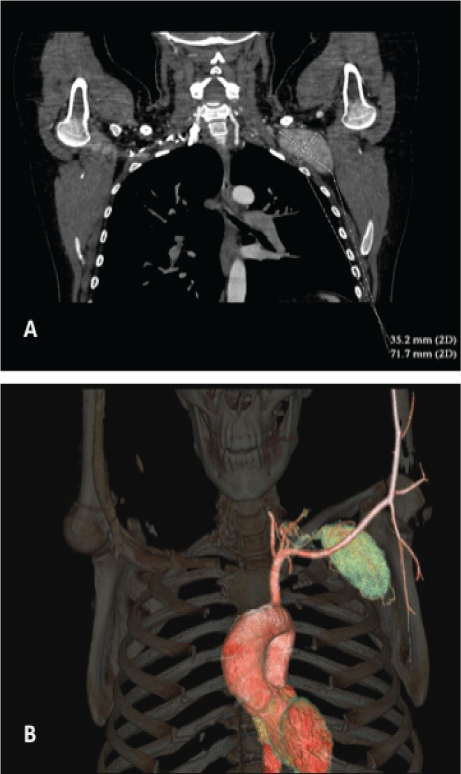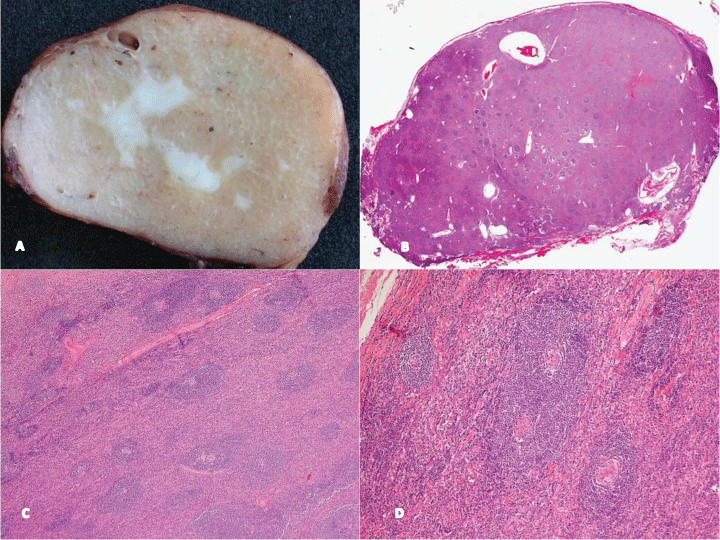Castleman's Disease (CD) is a rare benign lymphoproliferative disorder of uncertain origin which most commonly involves the mediastinum but rarely affects the axilla. We report a case of voluminous axillary unicentral CD, detected due to palpation of a painless mass in the left axilla in a healthy 32-year-old woman.
Ultrasound and Computed Tomography (CT) imaging revealed a 7 cm left axillary-supraclavicular lymph-node capsulated with no vascular stenosis. A needle biopsy was performed and a histological examination revealed typical hyaline-vascular type CD.
A careful surgical excision was performed with uneventful postoperative course and was dismissed after five postoperative days. Six months later CT scan showed complete remission. Although primary axillary localization of CD is rare, it is a possible cause of peripheral lymphadenopathy. A complete surgical excision is mandatory.
Castleman disease, Axillary lymphoadenopathy, Lymphoproliferative disorder, Thoracic surgery
Castleman's Disease (CD) is a rare non-neoplastic Lymphoproliferative disorder, first described in the 1956 report by Benjamin Castleman [1], who identified a series of solitary hyperplastic mediastinal lymph-nodes with small atrophic germinal centers resembling Hassall's corpuscles of the thymus.
Although most of the CD occurred in the thorax (70%) and commonly involved the mediastinum and the neck (40%), it rarely affected abdomen-pelvis (12%) and axilla (4%). Furthermore, CD has been classified as either Unicentric CD (UCD) or Multicentric CD (MCD) according to the different anatomical distribution of adenopathy [2].
Histologically CD includes four subtypes: (1) Hyaline-Vascular (HV) CD; (2) Plasma Cell (PC) CD; (3) HHV-8-associated MCD and (4) MCD, not otherwise specified [3].
We report the very unusual case of a patient with a voluminous axillary UCD, electively treated by curative surgery.
An axillary mass was detected due to palpation of a painless mass in the left axilla in a healthy 32-years-old woman (BMI: 30).
Clinical examination revealed the presence of an enlarged axillar lymph-node with no other palpable lymph-nodes. Examination of the cardiovascular and respiratory systems revealed no pathological signs. The initial differential diagnosis was cat-scratch disease due to the patient's contact with cats, bacterial infection (streptococcus and staphylococcus), viral infection (Epstein-Barr virus, Cytomegalovirus, HIV and HHV-8) and neoplastic lymphoproliferative disorders/lymphoma. All her serology was negative.
Ultrasound and whole body Computed Tomography (CT) imaging revealed a left axillary-supraclavicular lymph-node, of 72 × 35 mm, capsulated with no vascular stenosis or other lymphoadenopathy (Figure 1). The case was discussed in the multidisciplinary meeting and no further investigations were required because of the absence of other suspicious lesions. Therefore, we directly proceed to the needle biopsy that revealed a typical HV-type CD.
 Figure 1: (A) CT scan findings of left axillary- supraclavicular lymph-node; (B) CT image demonstrating the axillary mass in green. View Figure 1
Figure 1: (A) CT scan findings of left axillary- supraclavicular lymph-node; (B) CT image demonstrating the axillary mass in green. View Figure 1
Careful surgical planning led to a complete excision being performed with careful attention paid to the capsular plane, brachial plexus and thoracic duct (Figure 2). The histological examination of the surgical specimen confirmed the diagnosis showing areas of fibrous tissue and micronodular pattern with follicular enlargement and expansion of the interfollicular areas. In particular, the lymph node exhibited vascular hyperplasia in the interfollicular areas and follicles with enlarges mantles and onion-skin germinal-centers (Figure 3).
 Figure 2: (A) Careful dissection of the left axillary mass paying attention to the capsular plane, brachial plexus and thoracic duct; (B) Respected specimen of axillary lymph-node (75 × 45 × 30 mm). View Figure 2
Figure 2: (A) Careful dissection of the left axillary mass paying attention to the capsular plane, brachial plexus and thoracic duct; (B) Respected specimen of axillary lymph-node (75 × 45 × 30 mm). View Figure 2
 Figure 3: Pathological findings of the axillary lymphadenopathy: (A) Grossly, the excised lymph node shows areas of fibrous tissue and micronodular pattern; (B) Macro inclusion of the lymph-node showing follicular enlargement and expansion of the interfollicular areas; vessels are prominent and fibrous bands are evident (H&E, 2X); (C,D) The lymph-node exhibits vascular hyperplasia in the interfollicular areas and follicles with enlarges mantles and onion-skin germinal-centers (H&E, c-10X; d-20X). View Figure 3
Figure 3: Pathological findings of the axillary lymphadenopathy: (A) Grossly, the excised lymph node shows areas of fibrous tissue and micronodular pattern; (B) Macro inclusion of the lymph-node showing follicular enlargement and expansion of the interfollicular areas; vessels are prominent and fibrous bands are evident (H&E, 2X); (C,D) The lymph-node exhibits vascular hyperplasia in the interfollicular areas and follicles with enlarges mantles and onion-skin germinal-centers (H&E, c-10X; d-20X). View Figure 3
The patient had uneventful postoperative course and was dismissed after five postoperative days. Six months later CT scan showed complete remission.
CD is an uncommon, benign and heterogeneous lymphoproliferative disorder, not sex-linked, and may occur at any age, even though a previous systematic review demonstrated a disparity between UCD and MCD. UCD and MCD differ significantly also for histopathogenic type showing that HV-type was found in 78% of patients with UCD vs. 25% of patients with MCD; in contrast PC-type was found in 22% of patients with UCD and 75% of patients with MCD [2].
Herein we report a case of UCD HV-type, which was characterized by numerous follicles in the lymph-nodes, with hyalinised blood vessels and obliteration of the medullary sinuses.
She was surgically treated after having excluded infections and neoplastic lymphoproliferative disorders. Indeed, it could be associated with certain malignancies (large B-cell lymphomas, Kaposi sarcoma, osteosclerotic myeloma) and other diseases such as Polyneuropathy, Organomegaly, Endocrinopathy, Monoclonal Gammopathy and/or Skin Abnormality (POEMS syndrome).
It is crucial in the diagnostic setting to evaluate the centricity of CD. Indeed, centricity rather than histopathological type impacts on the long-term outcome, indicating that UCD, the more common form, had a significantly higher overall survival as well as disease free survival than MCD, in particular if UCD patients underwent resective as opposed to diagnostic surgery [2].
UCD may be asymptomatic, as occurred in our patient, or may present local anatomical symptoms based on its location, including B-symptoms and laboratory abnormalities. In contrast MCD has many clinical manifestations (fever, night sweats, severe fatigue, anorexia, and weakness and weight loss) [2].
Radiological diagnosis of CD is still very difficult, observing their characterizations in every lymphomatous lesion, benign or malignant, and other mesenteric diseases [4]. For this reason, to date, the gold standard approach to achieve a diagnosis remains the biopsy.
Resective surgery with no further multimodal approach is the mainstay of treatment in UCD and it is virtually curative in all cases reported thus far. On the other hand, there is no curative indication for surgery for MCD considering the similar outcomes obtained with immunechemoradiotherapy [2]. However, in these cases, surgery may play a role in performing biopsies for a full histopathological diagnosis or to debulk dominant foci of MCD.
In conclusion, complete surgical resection is the treatment that delivers the best results for UCD. Primary axillary localization of CD is a rare but possible cause of peripheral lymphadenopathy.
None.
None to declare.